There’s a reason design thinking, a process for creative problem solving and a mindset for innovation, has been adopted by many of the world’s leading brands and taught at Stanford, Harvard, and MIT. As an iterative, human-centered process used to uncover solutions for complex problems, design thinking has shown to boost long-term innovation and improve profit tenfold for companies that incorporate it into their practices.
“Design Thinking is a human-centered approach to innovation that draws from the designer’s toolkit to integrate the needs of people, the possibilities of technology, and the requirements for business success”
-Tim Brown, President of IDEO.
Despite its obvious benefits, implementing and executing Design Thinking at a company isn’t necessarily easy. It requires applying the methods at the right time and for the right reasons. In my role as Founder & CEO Mindhatch for the past seven years, and as an innovation strategy consultant at Deloitte before that, I have encountered several obstacles that prevent organizations and teams from getting the most out of design thinking. As someone who most often uses their design thinking expertise when collaborating with and coaching those who are new to the methodology, I have some experience in surmounting those obstacles.
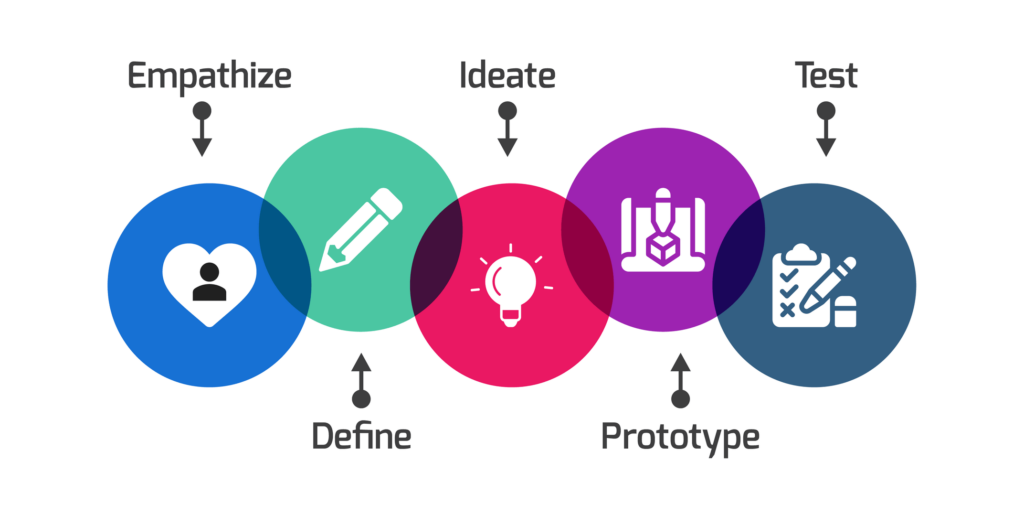
What follows are some of the most common hurdles I see arise during each of the five stages of the Design Thinking process—Empathize, Define, Ideate, Prototype, and Test—and some approaches I encourage for overcoming them.
1) Empathize
The first phase in the application of Design Thinking is to Empathize, meaning you must achieve a deep understanding of your customer or user’s needs, wants, and behaviors.
The biggest hurdle I have seen companies encounter during this initial phase of Design Thinking is apprehension when it comes to gathering customer feedback and speaking with customers in a human-centered way rather than via anonymous surveys. This apprehension often stems from fear of what the customer may say, or uncertainty around how to develop the internal processes necessary to gather deep, empathetic, human-centered feedback.
For instance, some companies refrain from asking for customer feedback because they are afraid of what they might find out, or they don’t want to know because what they learn may invalidate a path the organization is already on. Some companies avoid gathering client feedback because they are unsure how to gather qualitative customer data with integrity. Regardless of the reason, refusing to collect and integrate customer insights stifles a company’s ability to fully address complex business challenges issues with Design Thinking, which then inhibits company growth and the ability to retain customers.
If I encounter hesitancy in an organization about doing empathic qualitative research with customers (“Can’t we just send a customer satisfaction survey?”) I will dig deep in my memory and tap into what made me fall in love with Design Thinking all those years ago: the customer-centric methods of Design Thinking make it a de-risker for solution development. Talking to your customers doesn’t put you at risk; on the contrary, it helps you avoid the significant risks you’d otherwise take by building products and services based on your own assumptions of what customers want.
“If you ever have to think to yourself, ‘well, a general survey isn’t the right way to go about informing this decision, but the CEO wants to run one, what’s the worst that can happen?’ Brexit.”
Erika Hall, Mule Design and Author of Just Enough Research
Without a good understanding of your customers, which Design Thinking’s empathetic tools can help validate, you are at risk of putting resources behind a solution no one wants. By counseling people into recalling that empathizing with customers is a key feature of Design Thinking’s ability to reduce business risk, I can help clients get over the hurdle of fearing what customers might tell them.
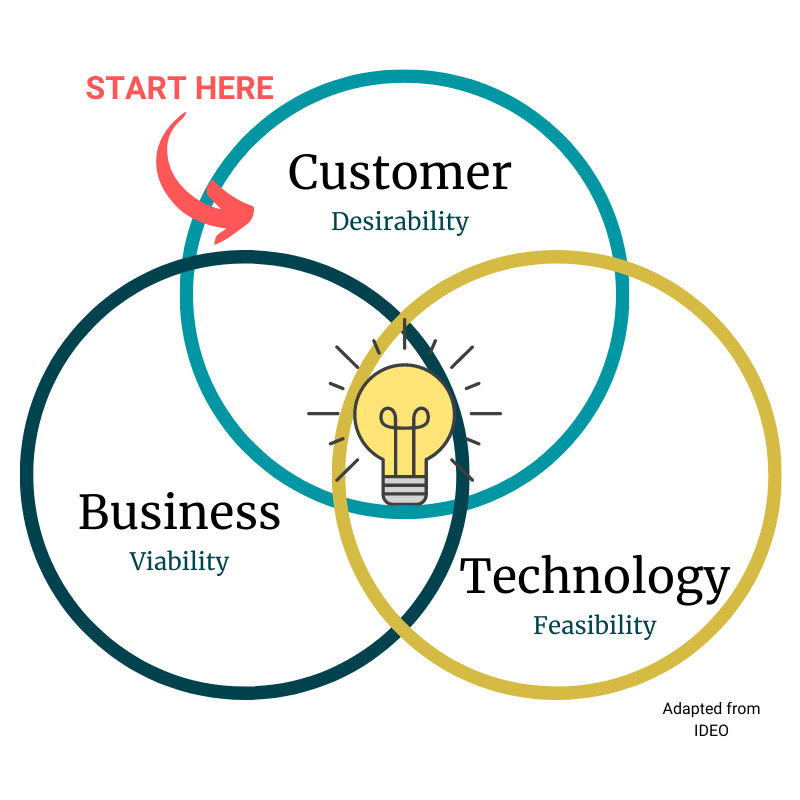
2) Define
In the second stage of Design Thinking, Define, you will narrow down the list of customer problems you’ve discovered in the Empathize phase to those that are most worth solving. This is the moment when you define the hypothesis or problem statement (ideally, you’d select multiple hypotheses to test simultaneously) that you want the rest of your Design Thinking process to address. This scoping is especially important for those on the team who will ultimately build and implement the solution(s).
I find people tend to struggle less in the Define stage than in other stages of Design Thinking because it uses the narrowing, focus skills that we are most used to using in the workplace. But there are two common obstacles that I see arise during this phase: (1) forgetting about the customer perspective when defining the problem; (2) not making the problem statement “ideate-able.”
The ultimate goal of the Define stage is to “right-size” the problem(s) in a way that prioritizes the customer’s point of view and avoids prioritizing business or technological needs at the expense of serving the customer. It can be all too easy to lose sight of the customer insights you learned during the Empathize stage and let other factors (pre-existing business goals, current partnerships, technological abilities, resource constraints, etc…) muddy the waters. This can result in forcing ineffective solutions your customers don’t want. To avoid accidentally ignoring the needs of the customer during the Define stage, I will ask clients to do a gut check of their statements and watch out for any words such as “our” that indicate they are defining from the business perspective instead.
Another aspect of “right-sizing” a problem statement includes ensuring that it is what I call “ideate-able”—there should be many possible solutions that could potentially solve the problem. Often, I encounter tautology – the solution is embedded in the problem statement itself — when clients initially attempt to define their problem. For example, “How might we create an online community for board members that allows them to be more productive?” assumes the solution within it: an “online community” is what should be built. Instead, a statement such as “How might we enable board members to be more productive,” is open-ended enough to welcome multiple solution ideas that tackle the customer problem of productivity.
When I advise people and teams, I coach them into creating useful problem statements and ask them to do a mini-ideation on their own to see if their statement can yield multiple solutions.

3) Ideate
Ideate, the third phase of Design Thinking, is all about uninhibited brainstorming. This is when the team generates and documents any and all potential solutions to the problems they’ve defined.
The biggest challenge that can occur during the Ideate phase is an inability to fully capitalize on the creativity and diversity of the brains you have in the room. Remember, the goal here is to generate fresh ideas. Oftentimes, people offer up ideas they already had in the back of their mind coming into the session, instead of a solution that arose spontaneously during ideation. They might also be uninspired by a simplistic directive to “add all your ideas on this wall,” without any additional structure or stimulus.
If a group comes out of an ideation session with a dearth of bold ideas, it is usually the result of inadequate guidance.
“[Ideation] is not the same as a group of friends sitting on the sofa, thinking about how they may someday change the world. Ideation requires focus on the user and problem statement, keen awareness of group dynamics, and purposeful steering,” reports Interaction Design Foundation. “It is like a large boat in stormy waters. If the captain is unable to control the crew—their direction may be seriously affected, potentially leading to mutiny in the ranks.”
Whether you hire an outside Design Thinking facilitator or decide to select someone in your ranks to facilitate, your facilitator’s deep understanding of ideation, Design Thinking, and the art of facilitation is integral to the success of the Prototype phase and your Design Thinking project as a whole.
4) Prototype
The fourth stage of Design Thinking, Prototype, is about taking some of the solutions you ideated and building. Prototypes are early, small-scale versions of the product or process you came up with to address your problem statement and test your most important hypotheses.
The biggest challenge in the prototyping stage is that many organizations don’t see a need to do it or they aren’t adequately funded to prototype solutions before actually implementing them in the market. They may also incorrectly assume that a prototype needs to approximate the final “real thing” as possible before putting it in front of customers.
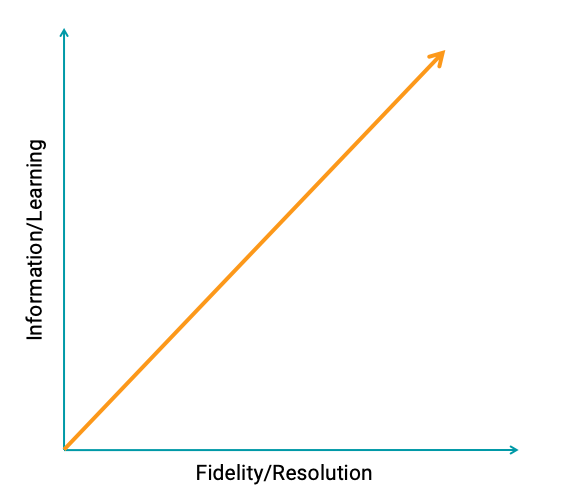
When clients hit roadblocks in this stage I like to share that there are different types of prototyping and that you can mold the process to your company’s circumstances. For instance, low fidelity prototyping, which involves the use of basic, low-cost resources, can lack a certain amount of realism but is also easily implemented in a time and cost-effective way. In contrast, high-fidelity prototypes come later on in the process and tend to be more polished and expensive, but can also give you more information about the viability of your design overall. My clients are always surprised by what they can validate or invalidate with a simple sketch or storyboard prototype of a product, service, or experience.
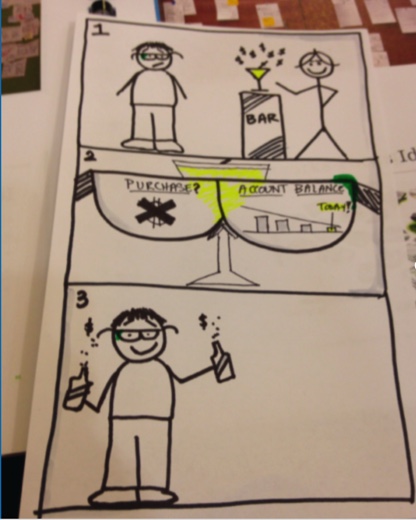
At Mindhatch, we stress the importance of prototyping ideas at whatever level you can accommodate. Prototyping (and prototype testing) are essential to understanding whether the idea you’ve come up with is really a potential answer to your problem statement. It de-risks the solution development process and can save you money and time in the long run.
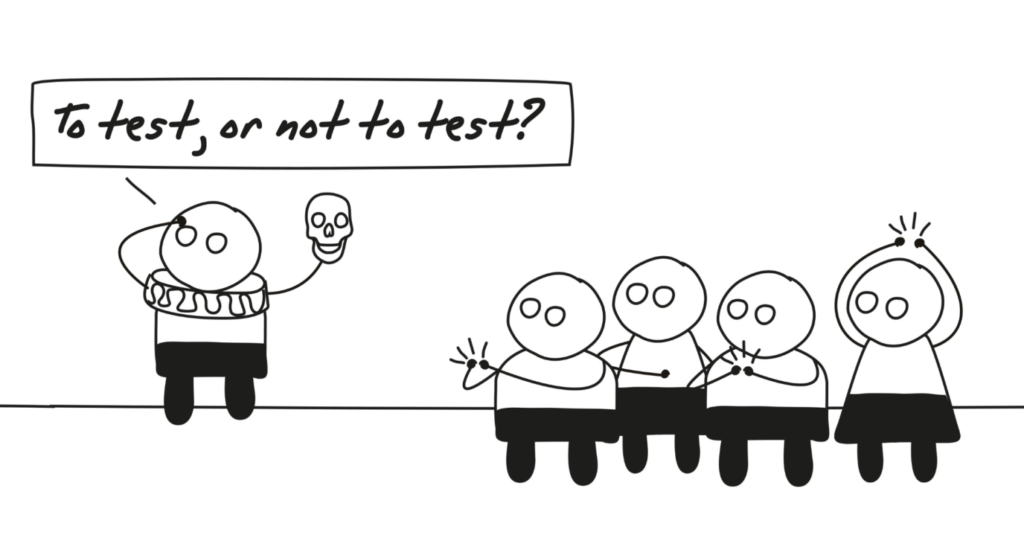
5) Test
The final stage of the Design Thinking process is Test, the phase when organizations actually take the prototype they’ve designed and investigate its viability with the customers you’re targeting. How the idea fares in their tests will give invaluable insight into what improvements the designs may need.
A common challenge at this stage is similar to that which organizations encounter in the Empathize stage—anxiety about sharing what they’ve been working on and getting feedback about it from the customer. But, the Test stage is a critical step in the Design Thinking process. Companies cannot know which solution ideas are worth investing in without it.
Having the courage to test is fruitful. In fact, most design thinkers recommend designers prototype and test more than one idea at a time in the early stages to home in on their most valuable ideas.
And, there’s another bonus to this stage: It’s another opportunity to deepen your rapport with customers. Prototype testing is, in essence, an opportunity for more empathy with customers. And like the Empathize stage, the Test stage de-risks the investments you have made in solution development.
When I encourage companies to tackle testing, I find I can reduce some hesitancy if I reiterate that Testing is not about testing the user (“Would they buy this?), but about testing the prototype (“Does this validate a hypothesis we have about solving the customer problem?). Shifting from focusing on the user to focusing on the prototype can help prevent designer/builder anxiety at this stage of the process and keep their eyes on the prize: serving and delighting customers.
—–
There’s no doubt that creative problem solving with Design Thinking takes a real, concerted, and collective effort. While every Design Thinking project is different, similar obstacles come up in each stage. By applying some of these tips, any organization can sail Design Thinking’s choppy waters, and achieve transformative business solutions and profit.

